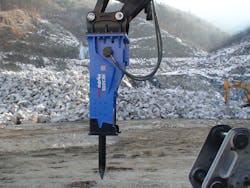In heavy-duty construction, hydraulic hammers, or breakers, are indispensable tools. Acquiring these tools can be a complex and costly process, and it can be tempting to buy them at an auction. Before doing that, however, weigh the potential costs and complications that could arise.
True cost of ownership for hammers
Purchasing a hydraulic hammer at an auction may seem like a steal. The prices are lower than buying a new or refurbished one. The actual cost of ownership is not limited to the upfront cost, however. The price tag at an auction does not factor in extra costs such as flow testing for optimal hydraulic flow and pressure, maintenance, or the need for technical support.
Even if you score a renowned brand, this doesn't automatically grant you access to the local dealer's support. The after-sales service can sometimes be nonexistent, leaving you alone to grapple with any arising issues.
Used or rebuilt hydraulic hammers purchased at an auction often come without a warranty. You may end up with a hammer that's ready to connect and hit, or you might have one that will only function after demanding extensive repairs.
An auctioned hydraulic breaker can also present a dilemma when it comes to replacement parts. The availability and cost of these parts can be a significant consideration. There is often a good reason a hydraulic hammer ends up at an auction. It might need large repairs or be from a brand that struggles to sell independently.
If the hammer needs rebuilding, finding a reputable place offering parts at a discount becomes essential. Otherwise, the cost of parts for the rebuild can escalate beyond your initial budget.
Having accessible and up-to-date technical documentation, including a parts list, is another overlooked factor. Knowing the cost of major replacement parts before purchasing any hammer is wise, whether you are buying from an auction or from a dealer.
Is an auctioned hammer compatible?
A hydraulic hammer is not a one-size-fits-all tool. You might need to engage a fabricator for a custom bracket or a pin set to make it work with your carrier. Quick couplers that need special adapters are becoming common on carriers, but these are not standard on hammers.
The hammer size that aligns with your carrier also needs careful consideration. Although you might have a general idea of the carrier size alignment when purchasing at an auction, other variables such as pin size, impact class, and top bracket compatibility can affect the carrier range.
Hidden costs of auctioned hammers
- Flow testing: Professional flow testing for a hydraulic hammer should always be done when hooking up a hammer for the first time. This can become costly if you run into any issues.
- Technical support and maintenance: Repair costs can range from a few hundred to several thousand dollars, depending on the problem's severity. Independent technicians might charge anywhere from $50 to $150 per hour.
- Lack of warranty: Replacing a crucial component like a worn-out piston can cost between $500 to $9,000, an expense you'd need to cover without a warranty.
- Replacement parts: Costs can escalate quickly with a new seal kit ranging from $200 to $2,000 and a lower bushing costing between $300 and $900.
- Customization for compatibility: Fabricating a custom bracket can range from $1,000 to $5,000.
- Incorrect sizing: If a hammer purchased at an auction turns out to be an incorrect size for your carrier, you could face replacement costs or the cost of a new hammer, which can range from $15,000 to $40,000 for a mid-sized hydraulic hammer.
Remember, these are just estimates, and actual costs can vary. The key point is that while the initial auction price might seem like a bargain, the total cost of ownership could significantly exceed that initial price due to potential hidden costs and complications.
How to inspect a hydraulic hammer at auction
If you decide to buy at an auction, proper inspection is essential to avoid potential issues and hidden problems. Here are some tips:
- Examine the tool: Look for signs of excessive wear or damage. Check for cracks, leaks, or any visible damage on the tool's body.
- Inspect the bushings and chisel: These parts often wear and tear the most. If they look worn or damaged, they may need replacement soon.
- Look for leaks: Hydraulic hammers operate under high pressure. Any leaks could lead to significant performance issues.
- Check the accumulator: If the hammer has an accumulator, check its condition. A faulty accumulator can lead to a decrease in performance.
- Ask for operation history: Although this may not always be available at an auction, ask for records of repairs, maintenance, and general usage.
- Seek professional help: If you are not familiar with hydraulic hammers, consider asking a professional to inspect it for you. They can spot potential issues that an untrained eye might miss.
Remember, a thorough inspection can help you make a more informed decision and save you from future problems and unexpected costs.
No matter the route you take in buying your hammers and breakers, it is always a good idea to be well-informed and consider all costs associated with the purchase. Auctions may seem like a way to save money, but far too often, they cost you more in the long run.
About the Author
Rodney Johnson
Rodney Johnson, CEO of RJB Hydraulic Hammers in Largo, Florida, has more than 25 years of experience in Service Operations and Project Management. Prior to taking over at RJB Hydraulic Hammers, Rodney was in charge of Operations where he handled all aspects of product procurement through product delivery and support. Rodney has experience in multiple vertical industries and brings his extensive IT experience into managing systems applications for the company. While Rodney’s focus is on making sure the company runs efficiently, his first priority is customer service and support for our entire customer base throughout the full sales cycle.
